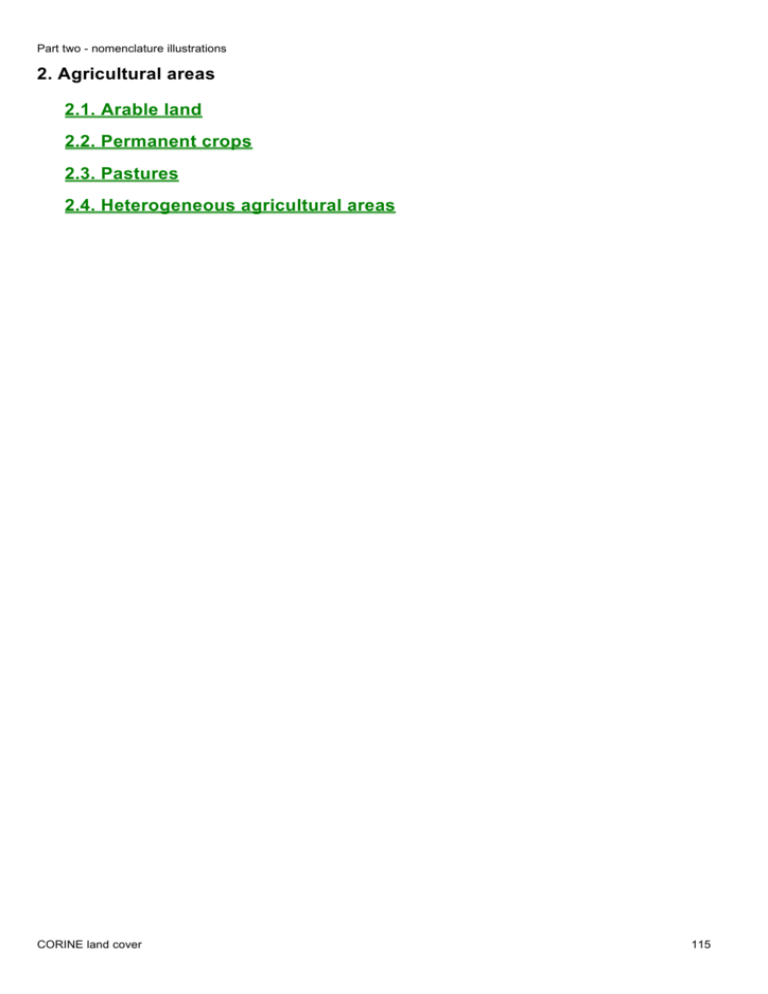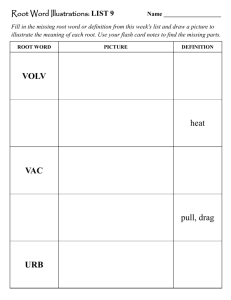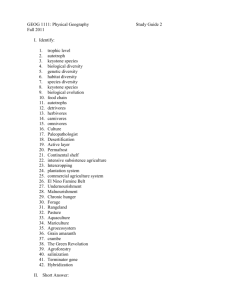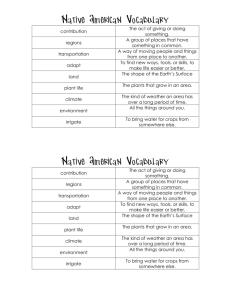CORINE land cover: Part II Normenclature
advertisement

Part two - nomenclature illustrations 2. Agricultural areas 2.1. Arable land 2.2. Permanent crops 2.3. Pastures 2.4. Heterogeneous agricultural areas CORINE land cover 115 Part two - nomenclature illustrations 2.1. Arable land 2.1.1. Non-irrigated arable land 2.1.2. Permanently irrigated land 2.1.3. Rice fields CORINE land cover 116 Part two - nomenclature illustrations 2.1.1. Non-irrigated arable land Cereals, legumes, fodder crops, root crops and fallow land. Includes flowers and tree (nurseries cultivation and vegetables, whether open field or under plastic or glass (includes market gardening). Includes aromatic, medicinal and culinary plants. Does not include permanent pasture. 2.1.1. Netherlands/Area: Hardenwijk Landsat TM 4.5.3. 1:100 000, May 1989 Interpretation The arable land shown here is made up of a large number of recently ploughed parcels (blue tone on the image). Ploughed land with no productive vegetal cover on the date of data acquisition belongs under this category. Care must be taken not to confuse item 2.1.1 with other agricultural cover (2.1.2, 2.3.1, 2.4.1 and 2.4.4). To remove all doubt it may be necessary to consult ancillary data (aerial photographs, agricultural calendars, statistics, multidate data). Temporary and artificial pasture (fodder crops) under rotation are to be included under 2. 1. 1. Topographic map (scale 1:100 000) CORINE land cover 117 Part two - nomenclature illustrations 2.1.2. Permanently irrigated land Crops irrigated permanently or periodically, using a permanent infrastucture (irrigation channels, drainage network). Most of these crops could not be cultivated without an artificiel water supply. Does not include sporadically irrigated land. 2.1.2. Spain/Area: Guadalquivir Landsat TM 4.3.2. 1:100 000, July 1986 Interpretation The date on which the satellite data are acquired must be carefully chosen to facilitate the identification of permanently irrigated arable land. Summer images will be more easily interpreted than spring images. Rice fields are not included in this category. Orography and hydrography of the land will indicate which areas are to be classified under 2.1.2. Orchards located in permanently irrigated land must be classified under 2.1.2 and not 2.2.2. Sprinkler irrigation is not to be considered here. Only flood or flush irrigation techniques are to be taken into account. TM false-colour composite 4.7.2. CORINE land cover 118 Part two - nomenclature illustrations 2.1.3. Rice fields Land prepared for rice cultivation. Flat surfaces with irrigation channels. Surfaces periodically flooded. 2.1.3. Portugal/Area: Coimbra Landsat TM 4.5.3. 1:100 000, August 1985 Interpretation This category is easily identified using multitemporal images, i.e. spring images, on which the rice fields are always flooded, and summer images, where the young plants can be located by the very high degree of reflection in the near infrared spectral band. Abandoned rice fields are not included under this heading. Landsat MSS 7.5.4 (scale 1:100 000, May 1986) CORINE land cover 119 Part two - nomenclature illustrations 2.2. Permanent crops 2.2.1. Vineyards 2.2.2. Fruit trees and berry plantations 2.2.3. Olive groves CORINE land cover 120 Part two - nomenclature illustrations 2.2.1. Vineyards Areas planted with vines 2.2.1. France/Area: Saint-Laurent-et-Benon SPOT 3.2.1. 1:100 000, May 1989 Interpretation There is no single photointerpretation key for classifying vineyards accurately. The relief and orientation of the slopes is always a good indication of the presence of vineyards. Pedological maps and agricultural statistics should be consulted where available. Topographic maps very often show the difference between category 2.2.1 and other arable land, though large-scale aerial photographs are better. there is a risk of confusion between tall vines and low orchards trained on espaliers of the same structure. Vines which have been abandoned but which still display the characteristic alignment should be classified under 2.2.1. Combined blue layer/planimetric representation of the 1:50000 map reduced to 1:100 000 CORINE land cover 121 Part two - nomenclature illustrations 2.2.2. Fruit trees and berry plantations Parcels planted with fruit trees or shrubs: single or mixed fruit species, fruit trees associated with permanently grasses surfaces. Includes chestnut and walnut groves. 2.2.2. France/Area: Orange SPOT 3.2.1. 1:100 000, June 1989 Interpretation Satellite images are a poor tool with which to identify orchards and berry plantations. Use of ancillary data (aerial photographs, topographic maps and various thematic maps) is essential. Plantations of trees for the production of walnuts, chestnuts and truffles are included in this category, Orchards of less than 25 ha surrounded by agricultural land (pasture or arable land) but which are nonetheless are included under item 2.4.2 (complex cultivation patterns). Orchards in which several types of tree are grown are included under 2.2.2. Nurseries and pasture planted with trees are not included under this heading. Topographic map (scale 1:50 000) CORINE land cover 122 Part two - nomenclature illustrations 2.2.3. Olive groves Areas planted with olive trees, including mixed occurrence of olive trees and vines on the same parcel 2.2.3. Portugal/Area: Beja Landsat TM 4.5.3. 1:100 000, August 1985 Interpretation Aerial photographs, agricultural statistics and the relevant thematic maps are indispensable tools for the ' interpretation of olive groves. lt is difficult to distinguish and separate categories 2.2.3 and 2.4.4. A visit to the site will sometimes be necessary. Topographic map (scale 1:100 000) CORINE land cover 123 Part two - nomenclature illustrations 2.3. Pastures 2.3.1. Pastures CORINE land cover 124 Part two - nomenclature illustrations 2.3.1. Pastures Dense grass cover, of floral composition, dominated by graminaceae, not under a rotation system. Mainly for grazing, but the folder may be harvested mechanically. Includes areas with hedges (bocage). 2.3.1. France/Area: Saint-Laurent-et-Benon SPOT 3.2.1. 1:100 000, May 1989 Interpretation The spectral signature of pasture depends on ground characteristics, including humidity. Wet pasture which may be flooded at certain times of the year (winter waterlogging of between I 0 and 30 cm depth) and which is used for grazing belongs under this heading and should not be classified as wetlands. Pasture is always located close to inhabited and cultivated areas, which means that high-lying pasture areas far from houses or crops should be classified under 3.2.1 (natural grasslands) and not under 2.3.1. Panchromatic aerial photograph CORINE land cover 125 Part two - nomenclature illustrations 2.4. Heterogeneous agricultural areas 2.4.1. Annual crops associated with permanent crops 2.4.2. Complex cultivation patterns 2.4.3. Land principally occupied by agriculture, with significant areas of natural vegetation 2.4.4. Agro-forestry areas CORINE land cover 126 Part two - nomenclature illustrations 2.4.1. Annual crops associated with permanent crops Non-permanent crops (arable land or pasture) associated with permanent crops on the same parcel. 2.4.1. France/Area: Digne Landsat MSS 7.5.4., September 1987 Interpretation This category covers associations within a single parcel, identifiable by specific spectral responses, rather than areas of polyculture with parcels given over either to annual crops or to permanent crops. Land units in a typical mosaic of small parcels of annual crops, pasture and permanent crops should be classified under category 2.4.2 (complex cultivation patterns). Parcels consisting of orchards mixed with non-associated annual crops represent less than 25% of the total surface area. Ground Photograph CORINE land cover 127 Part two - nomenclature illustrations 2.4.2. Complex cultivation patterns Juxtaposition of small parcels of diverse annual crops, pasture and/or permanent crops. 2.4.2. France/Area: Orange SPOT 3.2.1. 1:100 000, June 1989 Interpretation The above satellite image is a good illustration of parcels in an area to be classified under 2.4.2 (complex cultivation patterns). On satellite images this category always presents a very fine texture and an easily recognisable agricultural pattern. Topographic maps sometimes use symbols to indicate the biophysical content of this category. This reading covers land units identiflable by characteristic spectral responses and composed of small parcels of diverse annual crops, pasture and/or permanent crops, provided that none of these three categories covers an identifiable surface unit of more than 25 ha within a single land unit. Arable land, pasture and orchards each occupy less than 75% of the total surface area of the unit. City gardens are included under this heading. Topographic map (scale 1:50 000) reduced to 1:70 000 CORINE land cover 128 Part two - nomenclature illustrations 2.4.3. Land principally occupied by agriculture, with significant areas of natural vegetation Areas principally occupied by agriculture, interspersed with significant natural areas. 2.4.3. Luxembourg/Area: Diekirch Landsat TM 4.3.2. 1:100 000, August 1989 Interpretation This item of the nomenclature covers land units identifiable by characteristic spectral responses which distinguish them from their environment. In mountain areas it would be wrong to use heading 2.4.3 for the systematic classification of areas around villages consisting mainly of natural pasture. In these units, no homogeneous subset of 25 ha or more should be isolated in agricultural land or in natural areas (natural vegetation, forests, moors, grassland, water bodies or bare rock). Agricultural land occupies between 25 and 75% of the total surface of the unit. Hedged (bocage) areas are excluded from this heading (see heading 2.3. 1). The aerial photograph illustrates this type of land cover in the same area as the satellite image of Diekirch (Luxembourg). CORINE land cover Colour infrared aerial photograph 129 Part two - nomenclature illustrations 2.4.4. Agro-forestry areas Annual crops or grazing land under the wooded cover of forestry species 2.4.4. Portugal/Area: Alcador do Sal Landsat TM 4.5.3. 1:100 000, August 1985 Interpretation This category appears frequently in Southern Europe. It is usually linked to very extensive areas with a very variable spectral signature (different species, tree density, soil types). Delineation is not always easy as there is often a transitional zone between the natural vegetation and the Ploughed land. A good knowledge of the area and the use of aerial photographs are recommended. Ground Photograph CORINE land cover 130







